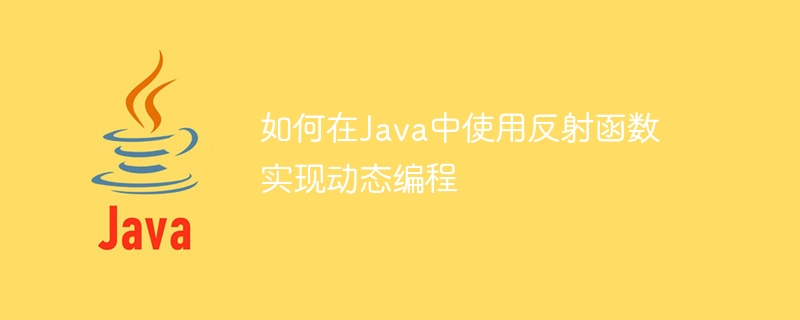Home >Java >javaTutorial >How to use reflection functions for dynamic programming in Java
How to use reflection functions for dynamic programming in Java
- WBOYWBOYWBOYWBOYWBOYWBOYWBOYWBOYWBOYWBOYWBOYWBOYWBOriginal
- 2023-10-20 09:18:26937browse

How to use reflection functions to implement dynamic programming in Java
Introduction:
In Java programming, reflection is a powerful technology that can be used when the program is running Dynamically obtain and operate information on classes, interfaces, methods, properties, etc. Through reflection, we can implement some dynamic programming functions, such as dynamically calling methods, obtaining dynamic information of classes, etc. This article will introduce how to use reflection functions to implement dynamic programming in Java and give specific code examples.
- Understand the concept of reflection
Reflection is a mechanism provided by Java that allows programs to obtain and operate information on classes, interfaces, methods, properties, etc. at runtime. Through reflection, we can dynamically instantiate objects, call methods, obtain properties, etc. Reflection can dynamically expand and modify program logic at runtime, making the program's functionality more flexible and extensible. - Use reflection to dynamically call methods
In Java, we can dynamically call methods through reflection. First, we need to get the Method object corresponding to the method to be called. Then, use the Method object's invoke() method to actually invoke the method. The following is a sample code:
import java.lang.reflect.Method;
public class DynamicInvokeMethod {
public static void main(String[] args) throws Exception {
// 获取String类的printMessage方法
Method printMethod = String.class.getMethod("printMessage", String.class);
// 创建一个字符串对象
String str = "Hello, world!";
// 调用printMethod对应的方法
printMethod.invoke(str, "This is a dynamic method call.");
}
}
class String {
public void printMessage(String message) {
System.out.println(message);
}
}In the above code, we first obtain the Method object corresponding to the printMessage method through the getMethod() method of the String class. Then, we create a string object and use the invoke() method of the Method object to call the printMessage method and pass in the parameters.
- Use reflection to obtain dynamic information of a class
In addition to dynamically calling methods, we can also use reflection to obtain dynamic information of a class, such as class name, method list, attribute list, etc. The following is a sample code:
import java.lang.reflect.Field;
import java.lang.reflect.Method;
public class DynamicClassInfo {
public static void main(String[] args) throws Exception {
// 获取String类的信息
Class stringClass = String.class;
// 输出类名
System.out.println("类名:" + stringClass.getName());
// 输出方法列表
System.out.println("方法列表:");
Method[] methods = stringClass.getMethods();
for (Method method : methods) {
System.out.println(method.getName());
}
// 输出属性列表
System.out.println("属性列表:");
Field[] fields = stringClass.getFields();
for (Field field : fields) {
System.out.println(field.getName());
}
}
}
class String {
public String message;
public void printMessage(String message) {
System.out.println(message);
}
}In the above code, we obtain the information of the String class through String.class. Then, we output the class name, method list, and property list. Through reflection, we can dynamically obtain class information while the program is running, thereby realizing some dynamic programming functions.
Conclusion:
By using Java's reflection mechanism, we can implement some dynamic programming functions to make the program's functions more flexible and scalable. In this article, we introduce how to use reflection functions to implement dynamic programming in Java and give specific code examples. I hope this article has been helpful to you in using reflection to implement dynamic programming.
The above is the detailed content of How to use reflection functions for dynamic programming in Java. For more information, please follow other related articles on the PHP Chinese website!

